-
1 of 253523 objects
Casket and table c 1824
Oak veneered with ebony, fitted with nineteen porcelain plaques and bronze chased and gilt mounts | 115.3 x 78.0 x 45.0 cm (parts .a and .b together) | RCIN 21637
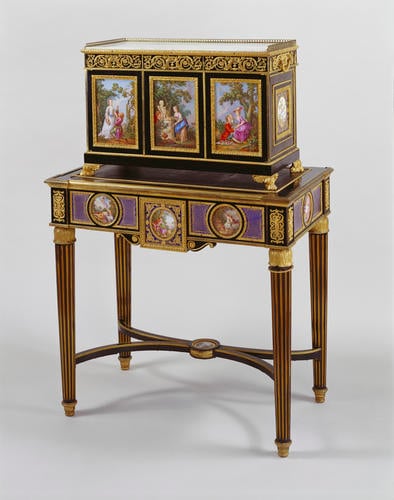

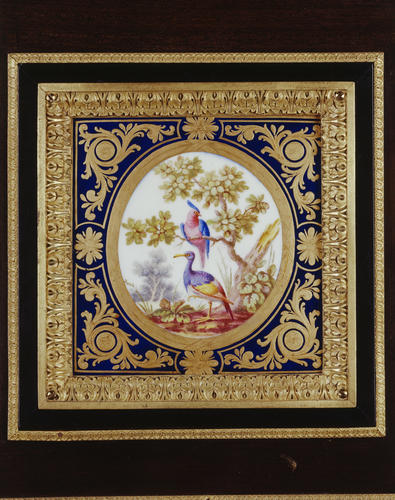
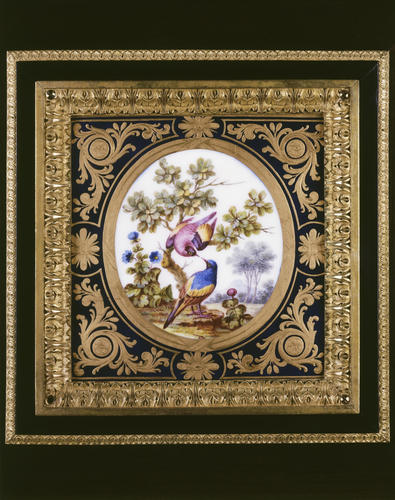
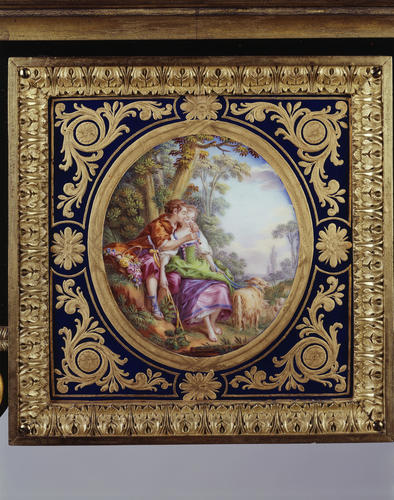

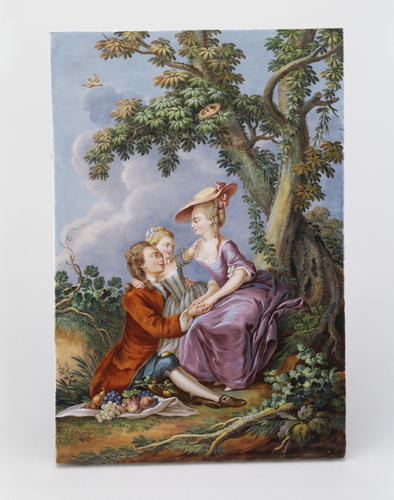
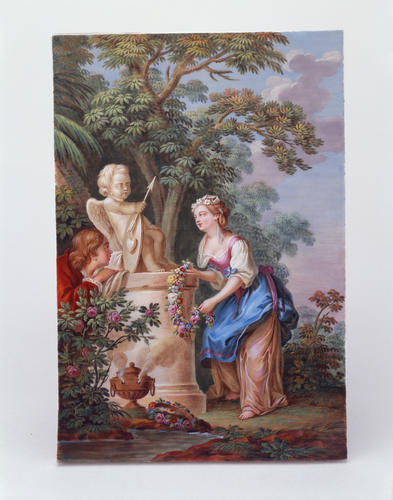
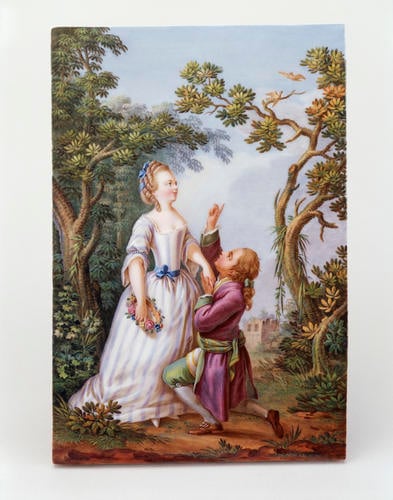
-
Rectangular porcelain-mounted cabinet on a similarly decorated table, inset with nineteen plaques, each with gilt metal border; cabinet with white marble top with pierced gilt metal gallery; on plinth base with gilt paw feet. Table with four fluted legs, joined by X-stretcher.
The table and coffer are inset with nineteen porcelain plaques (five on the coffer and fourteen on the table) are painted with four pastoral scenes, two mythological subjects, two birds, two still lifes, a trophy and eight trellis panels in gold on a blue ground. They are set in gilt bronze frames chased with acanthus foliage and water-leaves.
The casket, rectangular in shape has a slab of white marble and is fitted with a pierced gilt bronze gallery on three sides. The casket is supported on foliate lion-paw feet and is decorated along the length of the frieze with foliate arabesques hung with tasselled cords, accompanied on either side by a hinged foliate handle. The five plaques on the casket are of soft-paste Sèvres porcelain. The three front panels are painted with pastoral scenes forming a narrative sequence. On first a youth, on bended knee, points to two birds in the sky and with his other hand clutches the left hand of a standing maiden who holds a floral crown in her right hand. She is wearing a cream-coloured dress with lilac stripes. Round her waist is a blue ribbon and there is another in her hair. The youth is dressed in a short mauve coat trimmed with pale green material over green breeches. Round his waist is a green sash with gold stripes. On the second the maiden, with flowers in her hair, is draping a garland round a pedestal supporting a marble statue of a seated Cupid who holds an arrow and balances a shield bearing a heart. She is being watched by the youth hidden behind bushes. Lying at their feet is a floral wreath and a smoking incense burner. He is wearing a cloak deep orange in colour, and she a blue apron trimmed with a band of pink material over a beige skirt. On the third the youth is seated on the ground and holds a little girl in his arms, while she reaches out to the maiden seated beside them. Two birds in a nest add a symbolic touch to this happy scene. The youth is wearing a coat deep orange in colour, the child a striped pale blue and cream dress and yellow slippers, and the girl a long mauve dress and a straw hat edged in pink. The other two plaques to the side of the coffer are painted with two birds in a landscape setting in circular reserves, have a dark blue ground overlain in gold with flower-heads and foliate scrolls. The bands framing the scenes are tooled with two lines feathered on one side and interrupted by crossed ribbons at four points.
The table is supported on four round tapering legs veneered with ebony and inset with brass flutes; they are joined by curving stretchers which meet in a circular hub inset with a porcelain plaque. The capitals are in the form of reversed leaf cups, and the feet are shod in turned metal foliate shoes. Pierced foliate mounts decorate the corner panels. The top is lined in dark green morocco tooled with a gold border. The plaques on the table are of hard-paste porcelain, with the exception of the centre plaque on the front and the one on the hub of the stretchers which are soft-paste.
On the first plaque Cupid, who is clutching a bow in his left hand and an extinguished torch in his right, flies off, despatched (or released) by a partly draped seated female figure. Beside her reclines a youth holding two wreaths, one of laurel leaves, the other of blue flowers. At their feet are three more wreaths (white roses, red roses and mixed flowers, respectively). The fluttering drapery trailing behind Cupid is coloured blue shot with pink. The female figure, dressed in white, is seated on blue drapery; the male figure, dressed in a golden-coloured garment, is seated on crimson drapery. On the second a youth, who is teaching a shepherdess to play a recorder, is encircling her with his arms. She holds in one hand a ribbon attached to a halter round the neck of a sheep, and in the other a shepherd’s crook. Beside them is a basket of flowers. He is dressed in a russet-coloured cloak, pink trousers, and mauve cummerbund; the straps to his sandals are blue. The girl is wearing a blue-bodiced mauve dress with a green pinafore edged with pink, and a pink petticoat with a blue hem. On the third a running youth, led by Cupid holding a flaming torch, carries off in his arms a wildly gesticulating female figure. The woman, naked above the waist, is dressed in white. The man is dressed in mauve with ochre-coloured drapery.
The two still life plaques, on the sides of the table, comprise a bird’s nest with one egg, a bird pecking at cherries, a pineapple, peaches and flowers (roses, convolvulus, delphiniums, narcissi, poppies, etc.) and, on the secondd, it is composed of a tilted basket of flowers, a split pomegranate, grapes and flowers (poppies, peonies, convolvulus, delphiniums, iris, hollyhocks, etc.). Both still lifes rest on pink marble shelves. The final plaque, inset into the table’s stretchers, is composed of a circular reserve is painted in muddy colours with white chicks nesting in an upturned pink-lined and red-plumed helmet partly covered by a white cloth. The helmet rests on a sabre and shield and is partly covered by a spear. Flanking the trophy are two flowering bushes (roses to the left). Encircling the reserve is a matt gold band tooled with an indistinct foliate motif and an outer blue border overlain in gold by four trefoil motifs alternating with stars.
The table and casket formed part of the stock of the Parisian dealer Philippe-Claude Maëlrondt. They can be identified in the inventory, dated 31 May 1824, drawn up after his death. The two pieces were lots 327 and 328 in the sale held in his house, 13 boulevard des Capucines, on 15 November 1824 and following days. The entries differ hardly at all from those of the inventory, but there is one significant addition in the case of the table, namely that of its maker Bellangé. On this evidence the table, and by association, the coffer, were made by Alexandre-Louis Bellangé, almost certainly to the designs of Maëlrondt. At the sale the table fetched 1,401 francs and the casket 1,599 francs.
Although George IV was a buyer at the Maëlrondt sale, the table and coffer passed through other hands before finally entering his collection in May 1828. On arrival they were placed in St. James’s Palace. They were finally despatched to Windsor Castle, after his death, on 24 January 1834.
The porcelain plaques constitute the principal adornment, possibly even the raison d’être, of these two pieces of furniture. Although the plaques are given a semblance of unity by the use of matching mouldings to frame them, they form a disparate collection of panels, some designed as plaques, others adapted from other wares to serve as plaques, varying in date from 1774 to c.1820 and in theme from figure scenes to still lifes and trophies.
To our 21st century eyes the casket and table appear to be an assembly of plaques from many different sources - an unsatisfactory marriage of disparate elements. However, what we regard as suspect and dubious may not necessarily have been so by George IV and his contemporaries. It is not so much that they had the wool pulled over their eyes and were taken in by unscrupulous dealers but that they had different standards and concerns. The purist’s approach was not theirs. They may well have been impressed by the premier coup d’oeil, admiring Bellangé’s ingenious use of porcelain and gilt bronze shown to advantage against the black of the ebony veneer. Bellangé himself, one suspects, would have been proud of what he had achieved and Maëlrondt might boast that he had ‘improved’ certain pieces. George IV, one suspects, would have applauded such efforts if the overall effect was to add to the richness of the piece and so contribute effectively to the overall impression of opulence he wished to evoke in his interiors.
Table: Branded on the underside: BELLANGÉ RUE DES MARAIS 33 PARIS (Alexandre-Louis Bellangé, 1799-1863, accompanied by his address, 33 rue des Marais, where he moved in 1824).
Text adapted from French Porcelain: In the Collection of Her Majesty The Queen, London, 2009Provenance
Purchased in Paris by François Benois for George IV at a cost of £250; the entry in Benjamin Jutsham’s receipts’ ledger, dated May 1828, reads: ‘A Ladies Work Table, formed of Ebony, with a Drawer in Front, having 3 Circular Pannels of Seve Porcelaine in Landscape and Figures, the Centre Pannel a Pastoral Subject, the Circles enriched by Blue and Gold Porcelaine, encompassed by Or Molu chased Borders, the ends of the Table having 1 Circular Pannel Each of Seve Porcelaine Painted in Fruits and Flowers, Blue and Gold Seve Porcelaine Pannels, Scarlet Velvet Top, with a small Or Molu Rope border, the Table Mounted upon 4 Fluted Brass and Ebony Legs, capped and Fronted with chased Or Molu, having a Scroll Rail of Ebony and Or Molu , in the Centre of which is a Circular Pannel of Seve Porcelaine representing a Shield, Drapery &c &c. Height 2 F. 51/2 I. Width 2F. 7 I. Depth 1 F. 6 I. A Ladies boudoir Coffer, formed of Ebony, the Front opening in 2 Compartments with 3 Square Pannels of Seve Porcelaine Painted in Landscape, Male & Female Figures with Fruits wreathes of Flowers, Cupid, Essence Vase &c &c. the Pannels are encompassed by Chased Or Molu Borders, the End of the Coffer has each a Square Pannel of Blue and Gold Seve Porcelaine, in the Centre of which is a Circular compartment Painted in Landscape and Birds, Bordered to Correspond, the Top of the Coffer is richly mounted in open work in Scroll and leaf ornaments in Or Molu, White Marble Slab, and perforated Gallery, Mounted upon 4 Or Molu winged paws, an Or Molu handle at each End, the inside lined with various Woods, Yew Tree, Rose wood, Satin wood, containing 2 Small Drawers, One fitted up with 2 white Metal Dishes, for Ink and Sand. Height 1F. 4 I. Width 2 F. Depth 11 I.’
Included in the Pictorial Inventory of 1827-33 – RCIN 934867. The inventory was originally created as a record of the clocks, vases, candelabra and other miscellaneous items from Carlton House, as well as selected items from the stores at Buckingham House, the Royal Pavilion, Brighton, Hampton Court and Kensington Palace for consideration in the refurbishment of Windsor Castle.
-
Creator(s)
(porcelain manufacturer)(nationality)(porcelain painter)(porcelain painter)(furniture maker)(porcelain painter)(porcelain painter)Acquirer(s)
-
Medium and techniques
Oak veneered with ebony, fitted with nineteen porcelain plaques and bronze chased and gilt mounts
Measurements
115.3 x 78.0 x 45.0 cm (parts .a and .b together)
Other number(s)
Place of Production
Sèvres [France]